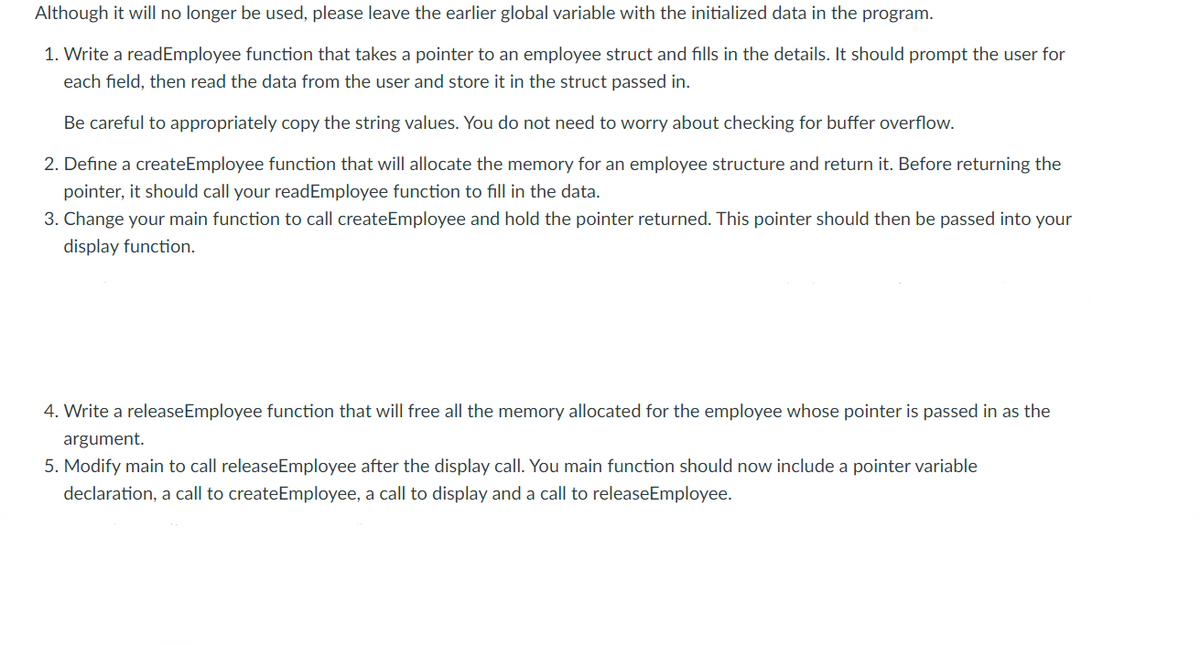#include struct employees { char name[20]; int ssn[9]; int yearBorn, salary; }; struct employees e = {"kim deen", {1,2,3,4,5,6,7,8,9}, 1998, 35000}; void display(struct employees *e) { printf("%s", e->name); printf(" %d%d%d-%d%d-%d%d%d%d", e->ssn[0],e->ssn[1],e->ssn[2],e->ssn[3],e->ssn[4],e->ssn[5],e->ssn[6],e->ssn[7],e->ssn[8]); printf(" %d", e->yearBorn); printf("\n$%d.", e->salary); } int main() { display(&e); return 0; }
#include struct employees { char name[20]; int ssn[9]; int yearBorn, salary; }; struct employees e = {"kim deen", {1,2,3,4,5,6,7,8,9}, 1998, 35000}; void display(struct employees *e) { printf("%s", e->name); printf(" %d%d%d-%d%d-%d%d%d%d", e->ssn[0],e->ssn[1],e->ssn[2],e->ssn[3],e->ssn[4],e->ssn[5],e->ssn[6],e->ssn[7],e->ssn[8]); printf(" %d", e->yearBorn); printf("\n$%d.", e->salary); } int main() { display(&e); return 0; }
Computer Networking: A Top-Down Approach (7th Edition)
7th Edition
ISBN:9780133594140
Author:James Kurose, Keith Ross
Publisher:James Kurose, Keith Ross
Chapter1: Computer Networks And The Internet
Section: Chapter Questions
Problem R1RQ: What is the difference between a host and an end system? List several different types of end...
Related questions
Question
//Below is the starting code for this homework assignment//
#include <stdio.h>
struct employees
{
char name[20];
int ssn[9];
int yearBorn, salary;
};
struct employees e = {"kim deen", {1,2,3,4,5,6,7,8,9}, 1998, 35000};
void display(struct employees *e)
{
printf("%s", e->name);
printf(" %d%d%d-%d%d-%d%d%d%d", e->ssn[0],e->ssn[1],e->ssn[2],e->ssn[3],e->ssn[4],e->ssn[5],e->ssn[6],e->ssn[7],e->ssn[8]);
printf(" %d", e->yearBorn);
printf("\n$%d.", e->salary);
}
int main()
{
display(&e);
return 0;
}

Transcribed Image Text:Although it will no longer be used, please leave the earlier global variable with the initialized data in the program.
1. Write a readEmployee function that takes a pointer to an employee struct and fills in the details. It should prompt the user for
each field, then read the data from the user and store it in the struct passed in.
Be careful to appropriately copy the string values. You do not need to worry about checking for buffer overflow.
2. Define a createEmployee function that will allocate the memory for an employee structure and return it. Before returning the
pointer, it should call your readEmployee function to fill in the data.
3. Change your main function to call createEmployee and hold the pointer returned. This pointer should then be passed into your
display function.
4. Write a releaseEmployee function that will free all the memory allocated for the employee whose pointer is passed in as the
argument.
5. Modify main to call releaseEmployee after the display call. You main function should now include a pointer variable
declaration, a call to createEmployee, a call to display and a call to releaseEmployee.
Expert Solution
This question has been solved!
Explore an expertly crafted, step-by-step solution for a thorough understanding of key concepts.
Step by step
Solved in 2 steps

Recommended textbooks for you

Computer Networking: A Top-Down Approach (7th Edi…
Computer Engineering
ISBN:
9780133594140
Author:
James Kurose, Keith Ross
Publisher:
PEARSON

Computer Organization and Design MIPS Edition, Fi…
Computer Engineering
ISBN:
9780124077263
Author:
David A. Patterson, John L. Hennessy
Publisher:
Elsevier Science

Network+ Guide to Networks (MindTap Course List)
Computer Engineering
ISBN:
9781337569330
Author:
Jill West, Tamara Dean, Jean Andrews
Publisher:
Cengage Learning

Computer Networking: A Top-Down Approach (7th Edi…
Computer Engineering
ISBN:
9780133594140
Author:
James Kurose, Keith Ross
Publisher:
PEARSON

Computer Organization and Design MIPS Edition, Fi…
Computer Engineering
ISBN:
9780124077263
Author:
David A. Patterson, John L. Hennessy
Publisher:
Elsevier Science

Network+ Guide to Networks (MindTap Course List)
Computer Engineering
ISBN:
9781337569330
Author:
Jill West, Tamara Dean, Jean Andrews
Publisher:
Cengage Learning

Concepts of Database Management
Computer Engineering
ISBN:
9781337093422
Author:
Joy L. Starks, Philip J. Pratt, Mary Z. Last
Publisher:
Cengage Learning

Prelude to Programming
Computer Engineering
ISBN:
9780133750423
Author:
VENIT, Stewart
Publisher:
Pearson Education

Sc Business Data Communications and Networking, T…
Computer Engineering
ISBN:
9781119368830
Author:
FITZGERALD
Publisher:
WILEY